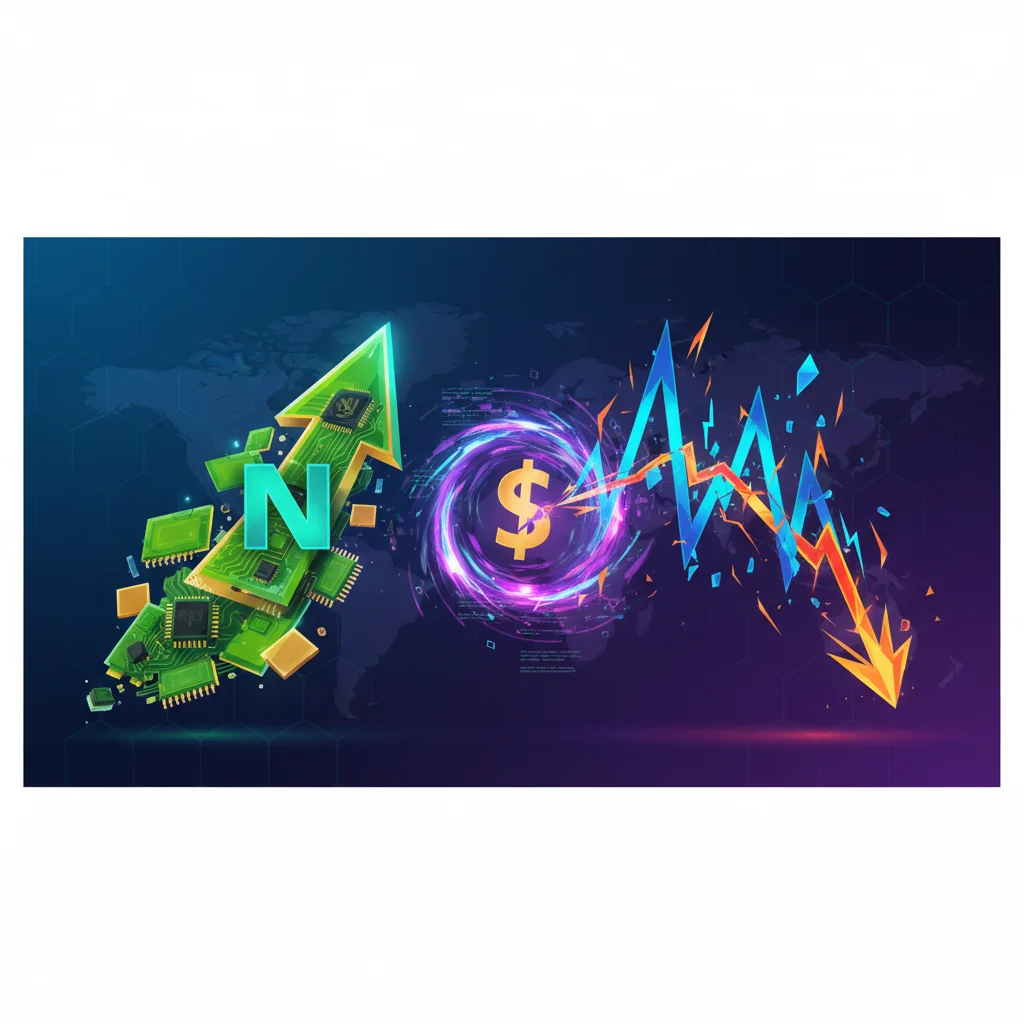
The Nvidia Paradox: Why a Booming AI Giant Can’t Calm a Jittery Stock Market
In the intricate ballet of the global stock market, news that a sector-defining titan has shattered expectations should, in theory, send waves of euphoria across trading floors. This was the scene many anticipated when artificial intelligence chip behemoth Nvidia unveiled its latest earnings report. The numbers were, by all accounts, spectacular. Yet, the reaction from the broader market was not a standing ovation, but a nervous shuffle towards the exits. Both US and Asian markets slid, a stark and perplexing response that left many investors and finance professionals scratching their heads.
This dissonance—a single company’s monumental success failing to quell widespread investor anxiety—is more than just a momentary blip. It’s a critical signal about the current state of the global economy, the psychology of investing, and the complex interplay between technological hype and macroeconomic reality. While Nvidia’s performance confirms the AI revolution is in full swing, the market’s reaction reveals a deeper truth: the looming shadows of inflation, interest rate uncertainty, and potential economic slowdown are proving too formidable for even the brightest star in the tech universe to dispel. This post will dissect this paradox, exploring the powerful undercurrents driving market sentiment and what it means for investors, business leaders, and anyone navigating today’s volatile financial landscape.
The Unstoppable Force: Nvidia’s AI Dominance
To fully grasp the market’s strange reaction, we must first appreciate the sheer scale of Nvidia’s success. The company has firmly positioned itself as the primary architect of the AI boom, providing the high-powered graphics processing units (GPUs) that are the lifeblood of generative AI models like ChatGPT. Their latest financial results were not just good; they were a testament to a company firing on all cylinders. While the original BBC report highlighted strong sales, the actual figures are staggering. For its fiscal first quarter of 2025, Nvidia reported revenue of $26.04 billion, an 18% increase from the previous quarter and a colossal 262% increase from a year ago (source).
This isn’t just a story about one company’s triumph; it’s a barometer for the entire AI industry. Every major tech company, from Microsoft to Google to Meta, is in an arms race to build out their AI infrastructure, and Nvidia is their primary supplier. This makes Nvidia a “picks and shovels” play in the AI gold rush—a seemingly surefire bet on the industry’s growth regardless of which specific AI application ultimately wins. So, when this linchpin of the tech world demonstrates such robust health, why did the broader market, including the tech-heavy Nasdaq, falter?
The Stealth Tax Squeeze: Why One in Four Britons Are on a Collision Course with Higher Taxes
The Immovable Object: Macroeconomic Headwinds Prevail
The answer lies in the persistent and powerful macroeconomic forces that are currently dictating the rules of the game. Investors are engaged in a delicate balancing act, weighing incredible micro-level corporate success against daunting macro-level risks. Right now, the macro side of the scale is laden with worry.
The Federal Reserve’s Long Shadow
The primary source of anxiety remains the U.S. Federal Reserve and its ongoing battle with inflation. Recent economic data has been a mixed bag, but key indicators suggest that inflation is stickier than hoped. The minutes from the Fed’s latest meeting revealed a cautious tone, with officials expressing a willingness to keep interest rates higher for longer to ensure inflation is truly tamed. Some policymakers even discussed the possibility of further rate hikes if price pressures re-accelerate (source).
For the stock market, particularly for growth-oriented tech stocks, high interest rates are kryptonite. They increase borrowing costs for companies, squeezing profit margins. More importantly, in the world of finance and valuation, higher rates decrease the present value of future earnings. A dollar earned five years from now is worth less today when interest rates are at 5% than when they are at 1%. This valuation pressure affects the entire market, creating a gravitational pull that even Nvidia’s stellar performance couldn’t escape.
A Global Economic Snapshot
The jitters are not confined to the US. The slump in Asian markets, from Japan’s Nikkei 225 to Hong Kong’s Hang Seng Index, points to a broader global concern. These markets are contending with their own unique challenges, including a sluggish economic recovery in China and currency pressures. The interconnectedness of the modern global economy means that weakness in one major region can easily spread, dampening investor sentiment worldwide.
To illustrate the disconnect, let’s look at some key market and economic indicators surrounding the news.
| Indicator | Status / Trend | Implication for Investors |
|---|---|---|
| Nvidia Q1 FY25 Revenue Growth (YoY) | +262% | Indicates massive, sustained demand in the AI sector. |
| US Consumer Price Index (CPI) | Persistently above Fed’s 2% target | Suggests interest rates will remain high, pressuring stock valuations. |
| Fed Funds Rate | Holding steady at a 23-year high | Increases borrowing costs and the “risk-free” rate of return, making stocks less attractive. |
| Major Market Indices (Post-Nvidia News) | Nasdaq, S&P 500, Nikkei 225 showed declines | Demonstrates that broad macroeconomic fears are overriding positive single-stock news. |
Beyond the Hype: Questioning the AI Rally’s Sustainability
The market’s hesitation also hints at a deeper, more existential question about the AI rally itself. After a meteoric rise in the valuations of AI-related stocks, investors are becoming more discerning and, frankly, a little nervous about a potential bubble.
The parallels to the dot-com boom of the late 1990s are hard to ignore. During that period, any company with a “.com” in its name saw its stock soar, often with little to no revenue to back it up. While today’s AI leaders like Nvidia are immensely profitable, the concern is about the broader ecosystem. Are the massive investments in AI infrastructure translating into widespread productivity gains and profits across the entire economy? Or is the value being concentrated in just a few key players?
The market’s recent behavior suggests investors are moving from a “buy everything AI” mentality to a “show me the money” phase. They want to see tangible returns on investment not just from the sellers of AI technology, but from the buyers as well. This growing skepticism is a healthy, if painful, maturation of the market. It forces a necessary distinction between genuine, sustainable growth and speculative hype. The field of financial technology, or fintech, is deeply involved in this, with algorithmic trading systems programmed to react instantly to shifts in sentiment and valuation metrics, potentially amplifying this cautious turn.
Solving the Financial Crossword: A Modern Investor's Guide to a Complex World
Actionable Takeaways for a Conflicted Market
For investors and business leaders, this complex environment demands a nuanced approach. The old playbook may not apply when the market’s signals are so contradictory.
- Look Beyond the Headlines: The key takeaway is that single-company performance is not a reliable proxy for overall market health. It’s crucial to pay as much attention to macroeconomic indicators—inflation reports, central banking decisions, and employment data—as to corporate earnings.
- Diversification is Paramount: The concentration of the market’s recent gains in a few “Magnificent Seven” stocks has been a major theme. The current jitters are a stark reminder of the risks of an under-diversified portfolio. Spreading investments across different sectors and geographies can help mitigate the impact of a tech-specific downturn.
- Focus on Fundamentals: In a hype-driven market, solid fundamentals can be overlooked. In a nervous market, they become paramount. Look for companies with strong balance sheets, consistent cash flow, and realistic growth prospects. Profitability is king when capital is expensive.
- Understand the Role of New Technologies: While not directly related to the market slide, it’s worth noting how technologies like blockchain and decentralized finance are developing in parallel, often driven by a desire to create systems less dependent on the traditional central banking structures that are currently causing so much market anxiety.
Conclusion: A Market at a Crossroads
The curious case of Nvidia’s stellar earnings and the subsequent market slump is a powerful lesson in modern investing. It underscores that we are operating in a market governed by two powerful, conflicting narratives. One is a story of incredible technological advancement, led by AI, that promises a future of unprecedented growth and productivity. The other is a story of present-day economic challenges, where central banks walk a tightrope to control inflation without triggering a recession.
For now, the cautious narrative of macroeconomic reality is winning out. The market is signaling that until there is greater clarity on the path of inflation and interest rates, even the most spectacular corporate success stories may not be enough to spark a broad, sustainable rally. This isn’t necessarily a sign of impending doom, but rather a sign of a market that is becoming more rational, more discerning, and more deeply attuned to the complex forces of global economics. For those who can navigate this uncertainty with a clear eye on both the micro and the macro, the current volatility may yet present opportunities.


